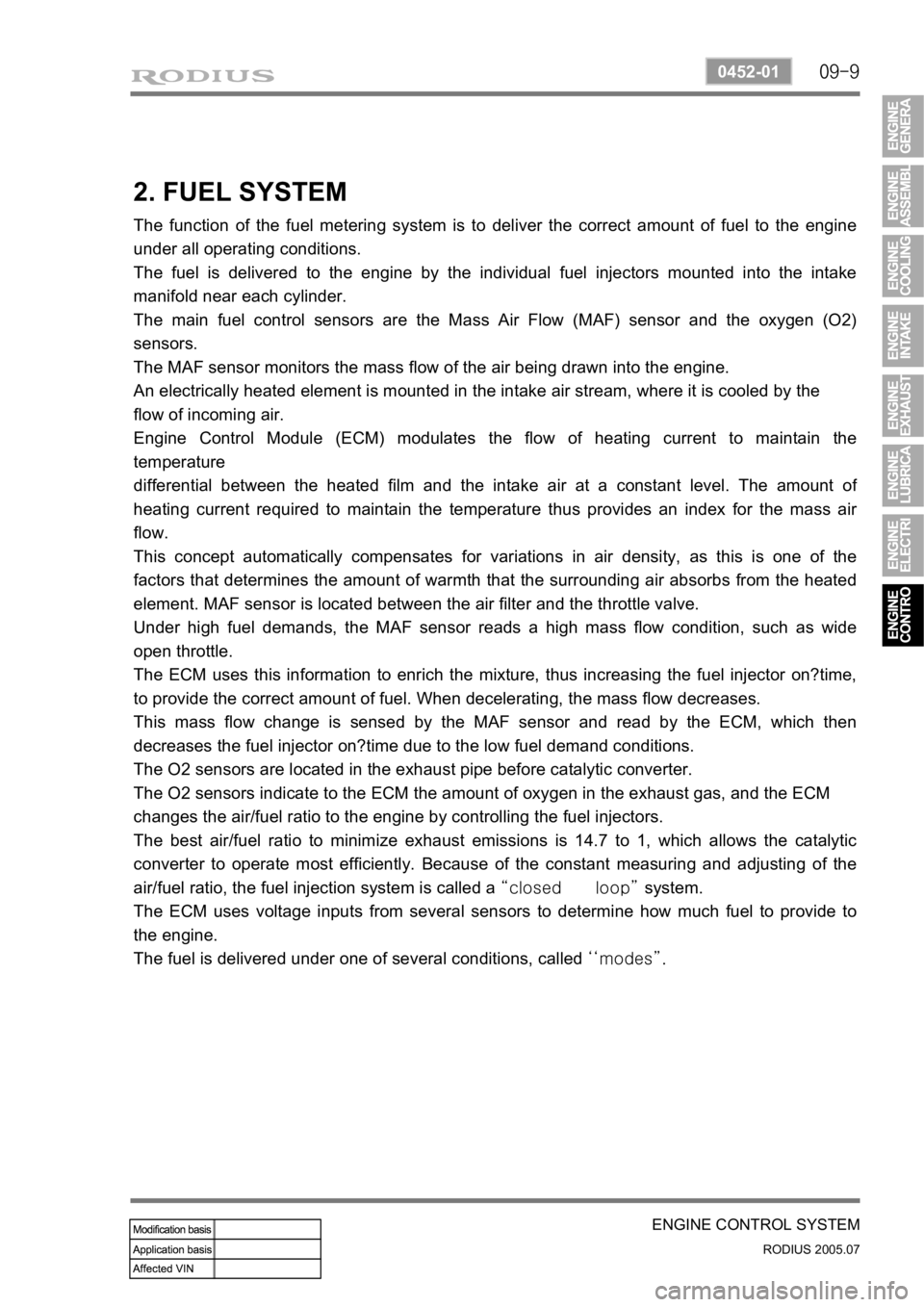differential SSANGYONG RODIUS 2005 Service Manual
[x] Cancel search | Manufacturer: SSANGYONG, Model Year: 2005, Model line: RODIUS, Model: SSANGYONG RODIUS 2005Pages: 502, PDF Size: 70.43 MB
Page 155 of 502

09-9
ENGINE CONTROL SYSTEM
RODIUS 2005.07
0452-01
2. FUEL SYSTEM
The function of the fuel metering system is to deliver the correct amount of fuel to the engine
under all operating conditions.
The fuel is delivered to the engine by the individual fuel injectors mounted into the intake
manifold near each cylinder.
The main fuel control sensors are the Mass Air Flow (MAF) sensor and the oxygen (O2)
sensors.
The MAF sensor monitors the mass flow of the air being drawn into the engine.
An electrically heated element is mounted in the intake air stream, where it is cooled by the
flow of incoming air.
Engine Control Module (ECM) modulates the flow of heating current to maintain the
temperature
differential between the heated film and the intake air at a constant level. The amount o
f
heating current required to maintain the temperature thus provides an index for the mass ai
r
flow.
This concept automatically compensates for variations in air density, as this is one of the
factors that determines the amount of warmth that the surrounding air absorbs from the heated
element. MAF sensor is located between the air filter and the throttle valve.
Under high fuel demands, the MAF sensor reads a high mass flow condition, such as wide
open throttle.
The ECM uses this information to enrich the mixture, thus increasing the fuel injector on?time,
to provide the correct amount of fuel. When decelerating, the mass flow decreases.
This mass flow change is sensed by the MAF sensor and read by the ECM, which then
decreases the fuel injector on?time due to the low fuel demand conditions.
The O2 sensors are located in the exhaust pipe before catalytic converter.
The O2 sensors indicate to the ECM the amount of oxygen in the exhaust gas, and the ECM
changes the air/fuel ratio to the engine by controlling the fuel injectors.
The best air/fuel ratio to minimize exhaust emissions is 14.7 to 1, which allows the catalytic
converter to operate most efficiently. Because of the constant measuring and adjusting of the
air/fuel ratio, the fuel injection system is called a “closed loop” system.
The ECM uses voltage inputs from several sensors to determine how much fuel to provide to
the engine.
The fuel is delivered under one of several conditions, called ‘‘modes”.
Page 222 of 502

0-3
PROPELLER SHAFT
RODIUS 2005.07
3310-01
3310-01PROPELLER SHAFT
1. PROPELLER SHAFT GENERAL INFORMATION
The propeller shaft transfers the power through
the transmission and transfer case to the
front/rear axle differential carrier (final reduction
gear). It is manufactured by a thin rounded steel
pipe to have the strong resisting force against
the torsion and bending. Both ends of propelle
r
shaft are connected to the spider and the cente
r
of propeller shaft is connected to the spline to
accommodate the changes of the height and
length. The rubber bushing that covers the
intermediate bearing keeps the balance of rea
r
propeller shaft and absorbs its vibration.
2. SPECIFICATION